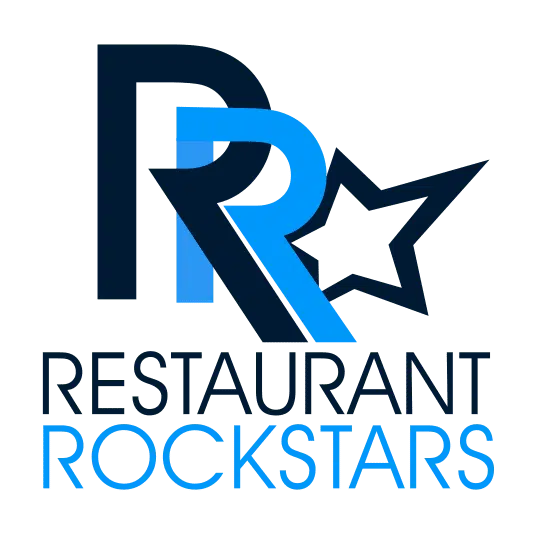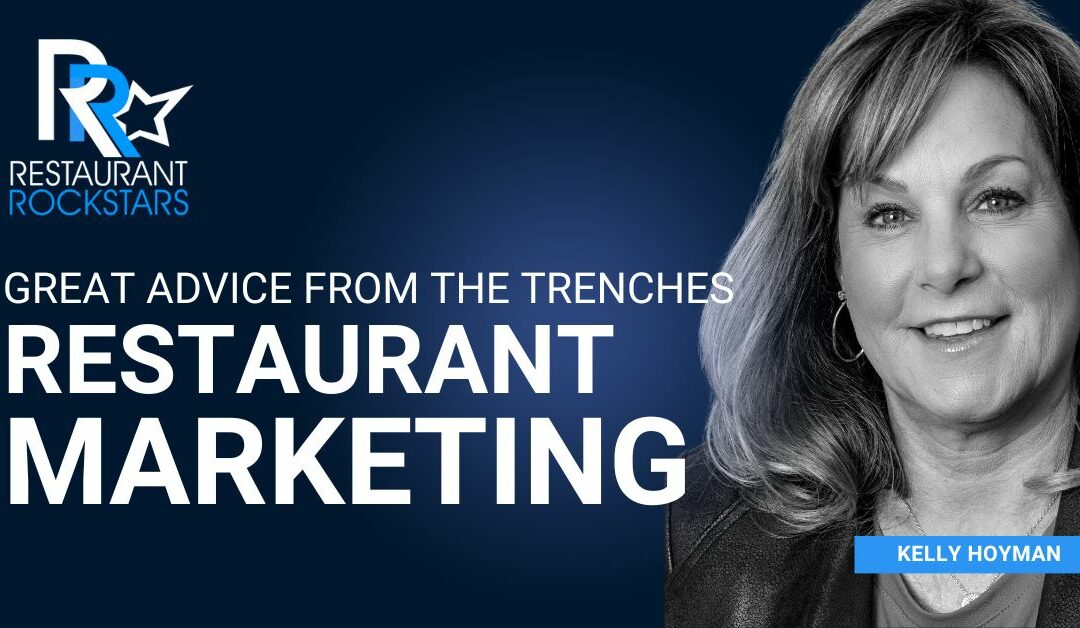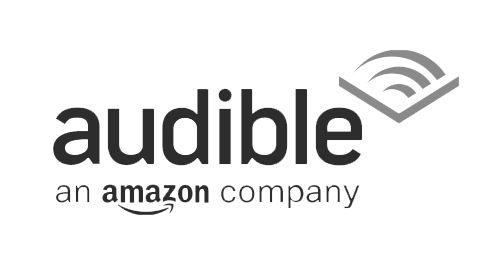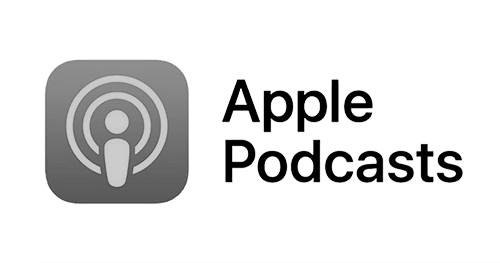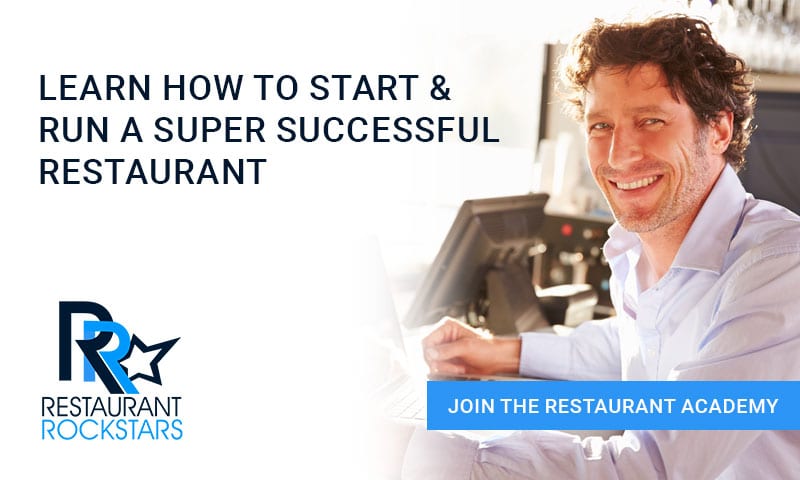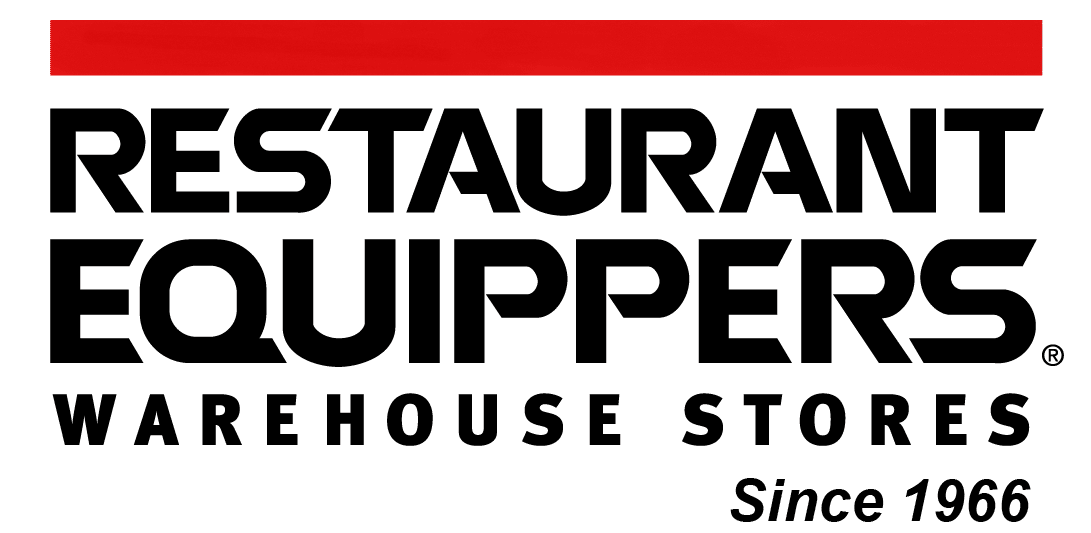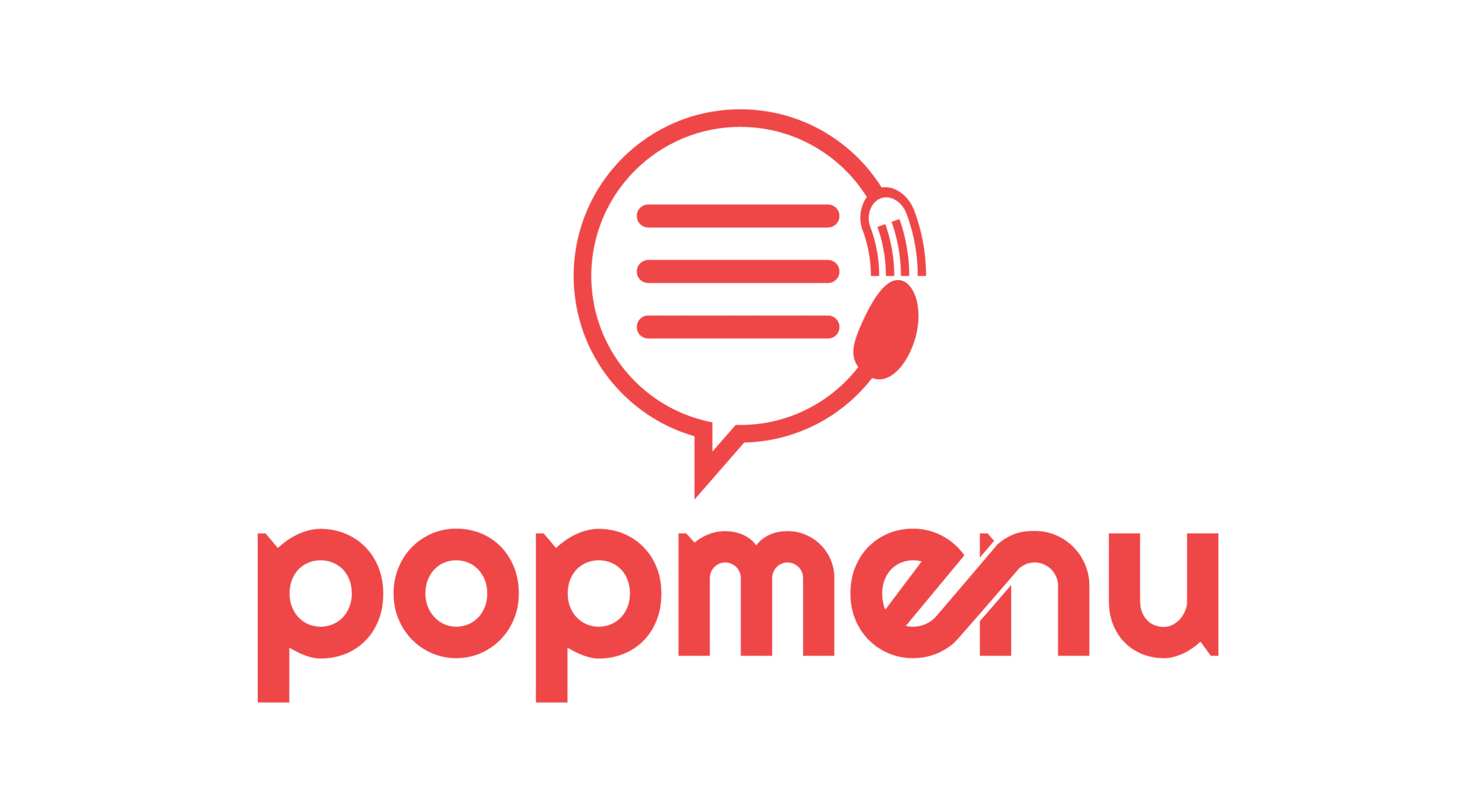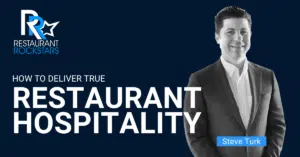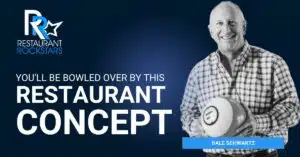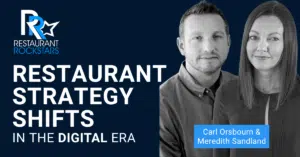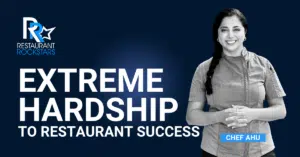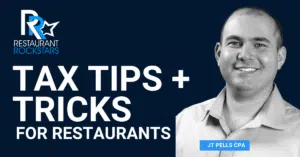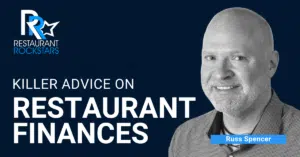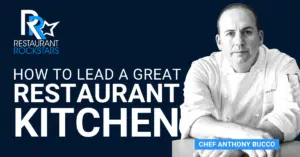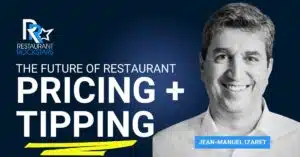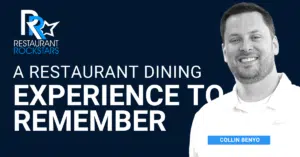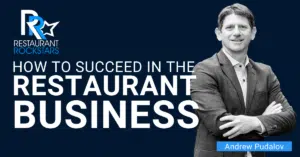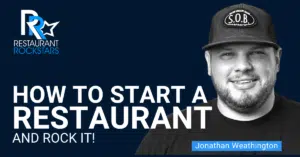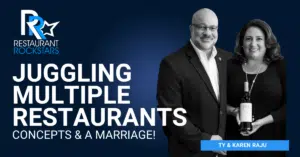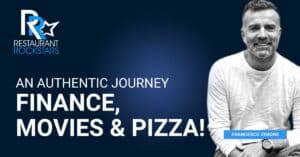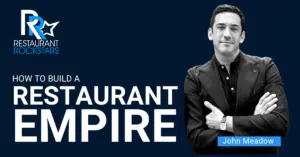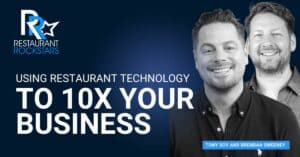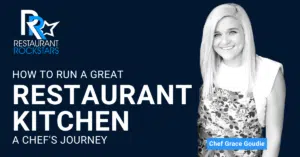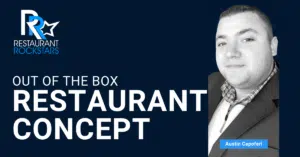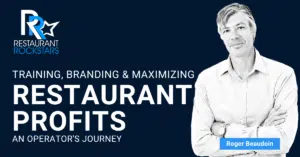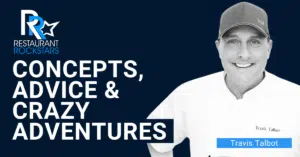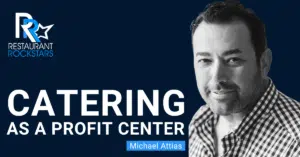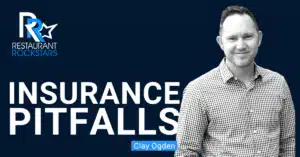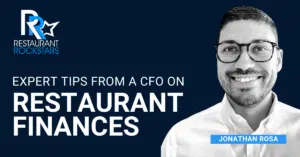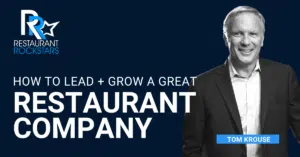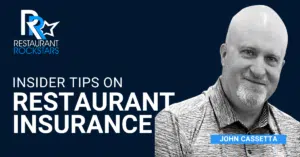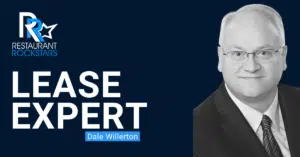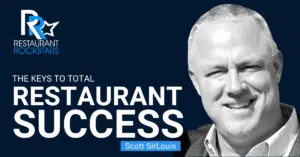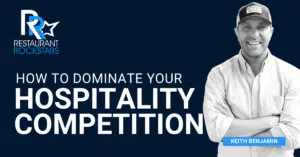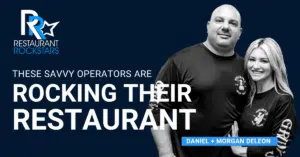Restaurant Rockstars Episode 380
Great Restaurant Marketing Advice from The Trenches
LISTEN HERE OR ON YOUR FAVORITE PODCAST PLAYER
Effective restaurant marketing is critical to your business success.
Far too often I see operators and their leaders throwing thousands of good marketing dollars after bad on unproven and un-trackable ideas. In this episode of the Restaurant Rockstars Podcast, I’m speaking with Kelly Hoyman, Vice President of Marketing for an 85-unit concept called Wings and Rings. Kelly brings 30 years of proven restaurant marketing expertise to this episode.
Listen as Kelly shares all things restaurant marketing including:
- Lessons learned from 17 years in restaurant marketing for McDonald’s.
- The role restaurant marketing plays in your own restaurant’s success
- Essential and foundational brand-building
- How to track Return on Investment with any marketing idea
- The everyday importance of social media in your operation
- Up-leveling the guest experience as a competitive advantage
- Loyalty and Rewards programs that really work.
Whether you’re running a single location or building a national chain, Kelly offers great restaurant marketing advice from in the trenches! Don’t miss this episode. Listen, would you spend less than the cost of a fancy beer on boosting your restaurant profit? That’s right for just $7, my Restaurant Profit Maximizer course will show you proven ways to boost profit in your restaurant. Check it out https://restaurantrockstars.com/sp/restaurant-profits and then go Rock YOUR Profits and YOUR Restaurant! Roger
Connect with our guest:
Welcome back to the podcast. Thanks for being here. This episode is all about marketing. Very few of us are super effective restaurant marketers. My guest today, Kelly Hoyman, is the vice president of marketing for an 85 unit concept called Wings and Rings. Now, Kelly spent 17 years of her career in restaurant marketing for McDonald’s, and you know they know a thing.
Kelly’s going to advise us all about creating a strategic marketing plan that’s trackable. So you know exactly where the business is coming from and you can track the return on investment. This episode is about brand building. It’s very foundational. It’s all about marketing, so you’re not going to want to miss it.
Thanks so much to our sponsors, and thanks audience for being here. Hey, let me ask you a question. Do you have 7 to improve your restaurant profit? No, I’m not kidding. For less than the cost of a fancy beer, I have a course that’s called the Restaurant Profit Maximizer, and it’s all about ways you can boost the bottom line, increase your profits in your restaurant.
Check out today’s show notes. There’s a link there. All about how to boost your profit. And again, it’s called the Restaurant Profit Maximizer. On with the episode.
you’re tuned in to the Restaurant Rockstars Podcast. Powerful ideas to rock your restaurant. Here’s your host, Roger Beaudoin.
Rockstars, when I needed equipment for my former restaurants, I called Restaurant Equippers. I bought two large freezers during the pandemic that allowed me to sell all kinds of prepared foods and desserts. The shipping was fast, and best of all, the price was right on the money. Restaurant Equippers has served independent food service operators just like you going on 60 years.
You’ll find all the top names and extensive inventory at their huge warehouse stores in Ohio, Michigan, and New Jersey. You can shop Equippers. com or call their National Order Office at 800 235 3325. Their experienced specialists will help you get the best equipment and supplies and save you money.
Thousands of name brand products are available for immediate store pickup or shipment, just like me. When you need something, you need it now. Restaurant Equippers will make sure you get the equipment and supplies you need, when you need them, at a price you want to pay. They shop the world to find the best products and value.
Give Restaurant Equippers a call for all your equipment and supply needs or check their website Equippers. com.
Rockstars, not taking inventory is like leaving hundred dollar bills all over your restaurant. You just wouldn’t do that, so don’t leave inventory to chance. Listen, your inventory represents thousands, if not tens of thousands of dollars of food and beverage sitting in your business at any given time.
With so much chance for waste, spoilage, and loss, you really need to understand and manage all that value. Don’t mistake thinking that taking inventory is just figuring out next week’s order. That’s really just a small part of it. The most important piece is knowing and calculating the true value of all goods on hand to guarantee that your food and beverage costs are in line and staying in your restaurant’s sweet spot.
Listen, Sculpture Hospitality are the restaurant inventory experts. They’ve taken every restaurant’s pain point and made it simple, approachable, and accurate. They don’t just manage your food and beverage inventory, they give you a clear picture of your restaurant’s profitability. They have a range of service options to meet your needs and your budget.
From a hands on full service solution using one of their inventory experts, to a shared solution, or even a DIY, Sculpture Hospitality customizes the inventory solution to your operation. Take charge of your bar and restaurant inventory today. Get a free no obligation inventory consultation at https://SculptureHospitality.com/rockstar com.
Kelly, welcome to the show. So glad to have you here. How are you?
I’m great. Thank you for having me.
You are having an illustrious career, and I can’t wait to dive right in. But my audience knows I love to start with the backstory of my guest in hospitality. So take us where it all began for you, and then we’ll talk about your career trajectory.
From a hospitality perspective, I would say I started off in high school working for restaurants a small family owned Italian deli in my hometown, and continued with them through college being a server and learning all things about the restaurant, how to serve people, how to create a great experience, how to learn more about the menu, and so I would probably go back to high school as far as where I started.
Fantastic.
You covered some key things there about the people. It is all about the people, it’s all about the service, and I get the sense that as a server, it wasn’t just about product knowledge certainly plays a very important role in there, but you got to know people probably on a first name basis.
You probably treated everyone as if they were the most important person in the place because personality plays such a huge part in being a front of house person interacting with the guests. So I’m getting that from you.
Yeah, so I would say we definitely had a lot of regulars that would come in and first name basis know their existing order.
I think they came for the camaraderie and for the socialization. It’s interesting how well you’d get to know some of the regulars and the stories that they would share. And obviously coming to celebrate for graduations or birthdays or anniversaries. You became an extension of their family, I would
say.
Absolutely. Now, a lot of this episode, we’re going to talk extensively about marketing because you’ve spent so much of your career, 30 years plus in marketing. We’re going to get into all of that. But what you just said is so foundational to the marketing of a restaurant or business of any kind because the people, you yourself, when you were a server, were an ambassador for that business.
You were a brand builder for that business. You were responsible or had an impact on whether guests came back again because they had such an amazing time. Or they went on to some other restaurants. So that is such a foundational element. I’m really glad you shared that. Let’s talk about What happened after that?
You went to college, obviously. Did you stay in this business, and was it a while before you started working with McDonald’s?
It was a while. I graduated from UC Santa Barbara, and the economy in Southern California at the time was not strong. And so I took a job with an insurance company, and ended up leaning more into marketing, even though I was doing something completely different.
Found opportunities to do community engagement. How to build our brand and our reputation doing and volunteering for different events around the community, starting fundraisers to really get our name out, but just really, I think that’s an important part of the culture that I like to work in, is being in an environment where I feel like we’re doing a good job.
so much for joining us today and we’ll see you next time. Their slot club card and the customer segmentation of their database and what offers the gamblers would get based on how much money that they had spent worked with really high impact celebrities that were brand ambassadors for us and did a lot of the advertising for the casino for four years.
Okay, that’s excellent experience also. So I’m hearing about loyalty and rewards. So that’s obviously a big part of marketing. I don’t want to get into it now. We’re going to get into a little later once we, get into this conversation. But that is just another foundational element to building what I call affinity, which is that powerful sense of loyalty or belonging to a particular restaurant, and it sounds like that is a, you’ve laid that foundation, and that’s what you’re going to tell us about in your current role.
So let’s Get into McDonald’s. Now, you worked 17 years and, obviously McDonald’s needs no introduction. Probably the world’s largest, most recognizable food service brand, international, of course. I don’t think there’s a country out there that doesn’t have a McDonald’s represented in it, right?
So that story unto itself is really dynamic. But tell us about your career, how you got started there, and did you have multiple positions there, and what did you do for McDonald’s?
So I pivoted from the casino, went to work for McDonald’s after I got my MBA and my Master’s of Marketing at CU Denver and started off as a marketing manager in the Denver region and really focused on developing marketing plans with the franchisees and the co ops.
Everyone’s got a different structure for how they develop and create their marketing plans. McDonald’s was unique in that The one area where the franchisees had a vote and could say no. was with marketing and so we had to develop business plans and business cases to present to the franchisees within this co op structure to approve any promotion that we wanted to do, whether that was a new menu item some type of giveaway.
creating some type of fundraiser, we had to get their approval and do a, full business case on that. Started in the Denver region, then moved over to Seattle and ended up in Chicago, which is one of their largest regions, obviously, having it be the backyard of their corporate office. And then ended up working for the corporate team.
Primarily in the field. Primarily working with a lot of franchisees and advertising agencies and putting together strategic marketing plans. So
that’s really interesting because you represented a large number of franchisees for McDonald’s. And now everyone thinks differently. Did you get a democratic vote where people would either say, Yay or nay, yeah, that’s a great idea, or no, I don’t want to participate in that.
Did it work that way or was it a different sort of formula?
No, it was pretty much, parliamentary procedure and following all of the criteria for running a meeting which the process helped a lot because we were required to send out pre reads about a vote 10 days in advance of the meeting so folks could read it, digest it, and ask questions.
I found that I’m a data driven, fact based person, And I found that there’s a population out there that really is focused on emotion. How is this going to impact my people? How is this going to impact the brand? And I realized very early on that we needed to write business cases that satisfied both Preferences of what’s the business case and what do we think we’re going to get from this promotion, but then on the flip side, how is it going to impact operations?
How is it going to impact my people? How can we make sure that the customer has a great experience in creating the sometimes it was a daily value offer that we knew we were going to operationally be challenging the restaurant. And so it also made me learn a lot more about the entire operations of the restaurant and not just about the marketing and the promotion and the advertising.
This is a fascinating topic because we’re talking about promotions here and I can go down two roads here and maybe there’s even more, but let’s talk about this. In my mind, there are limited time offers that are special promotions, but then there are things around certain holidays or events. Like when I was a kid, I remember something called the shamrock shake.
Do they still do that?
They do. They do the Shamrock Shake and the McRib. Those are probably the two most popular LTOs that they have on their plan every year. Okay,
so there are things that are just staples that have been happening for decades, right? Because we’re talking about a brand that’s, what, 70 plus years old now, perhaps even more?
I grew up with it as a kid, of course. And then there was the Shamrock Shake, and then there was the staple items that never changed, the Big Mac. The Filet O Fish, the basic cheeseburger, all that kind of stuff. I remember the hot apple pie when I was a kid and I used to love those. And I haven’t been in a while, so I don’t remember.
I don’t know if they still do them. No, they still have all those. Okay, great. All right. So see, this is consistency, which is so important in brand building and marketing. Let’s talk about what are some of the key learnings, you would say, because you spend 17 years with a huge company like that. There are certain takeaways that you will never forget that are just tried and true and proven.
And I’m trying to figure out if we can deliver some of this to the audience where these are ideas where the lightbulb goes off and they say, wow, that’ll work in my place. What does McDonald’s do that really makes them stay on top of the heap for seven, seven decades?
Obviously a couple of things.
The first is very data driven, fact based. They spend money on research and they really get to know the customer. And that can be a lot of different segments within the customer base. And I felt like McDonald’s really taught me that. How you communicate with the African American audience, the Asian audience, the Hispanic audience is different than how you would support what we call just general consumer at McDonald’s.
And so that really taught me to use different languages, different visuals, and even different products. Like when I was in the Seattle region, doing a SWOT analysis, sitting down, looking at what was working and what wasn’t, And We had a huge population of people that liked spicy food, and we didn’t really offer up on the menu items that you would describe as Spicy.
And so working with the national menu team put together a plan to test a hot and spicy chicken sandwich that performed really well. And they ended up doing sometimes in just the Hispanic markets as an LTO and eventually added it onto the menu because they realized that you’ve got to appeal to the different customer base with their taste.
Preferences. And we weren’t always good at doing that when you’re trying to serve it up to 15, 000 restaurants across the U. S. So I think that was one of the big learnings was really understanding your local consumer and what you should offer up from a taste profile that would meet their needs. When perhaps sometimes your main menu was a little more And that’s how you get to middle America, if you will.
Makes sense. Makes sense. I think
it was really important that we sat down and did the SWOT analysis and created a business plan. And so we would get franchises, suppliers, advertising agencies supply chain, and the corporate team all in a room, and we would develop a one, three, and five year plan. And staying really focused on what was happening from a business perspective, what the trends were saying, what we knew about our customer base.
What was our business plan? And then the marketing plan was really to support the business plan. So sometimes I think people want to just sit down and think, okay, what product or service should I offer up? But I think you need to take a step back and really focus in on. What your core competencies are, what service or product you’re providing that the customer wants and needs, and then how do you create a business plan around that entire strategic approach?
And then what are you going to market to let people know what you’re doing? And I think sometimes people. We’ll jump too much into the promotional LTO price perspective and not necessarily incorporate the customer experience, the technology the training that goes into how you’re going to keep your business moving forward and staying relevant for your customers.
Now that was an excellent answer and that We can peel that onion back a lot of different ways, but the things that really jumped out to me are business plan, strategic plan, SWOT analysis. You and I both have MBAs, but this is a business not traditionally run by MBAs. So if I go to my typical listener, it’s like it could be an independent operator, it could be someone with multiple restaurants, some of them very successful, some of them looking for greater successes.
But it’s rare that people actually write a business plan about their business and they analyze it from the top down. And then they use that as a system to move the business forward. When we talk about a SWOT analysis, a lot of people don’t know that stands for what are your strengths, what are your weaknesses, what are your opportunities, and what are your threats.
And that is a really great. Analysis of your business if you take a fresh step back and not be so close to it, but really be honest with yourself. And what do we do really well? Where do we need to improve? What are our opportunities to move this business forward? And then what’s the threat that might be, impending against our business and how do we combat those things?
And that gives you a real broad look at your business. So thank you so much for sharing that. That is well and
spot on. You’re spot on as well because one of the things that you said about sometimes we have blind spots and we’re not aware what our true strengths are and what our true weaknesses are and sometimes we don’t want to admit to what the weaknesses are and the best thing you can do is Even do an audit of your social media and look at the customer comments.
Look at the emails that you get from your customers and what are they telling you about what your strengths and weaknesses are. Getting your restaurant management team, your company together, and having an honest dialogue. I have sat in many leadership meetings where folks didn’t really want to identify and acknowledge that we had weaknesses that we needed to address.
There was a little bit of a halo that everything that we’re doing is so wonderful. But then once you have that SWOT analysis done, it’s a great opportunity that you lean into your strengths. And that’s where you develop your business plan and your marketing plan. Cause the customer’s already giving you credit for those areas that you’re really good at.
The weaknesses then become a business planning process of how are you going to make those weaknesses less weak, and how are you going to tackle the opportunities that you have so that you can make them
strengths. Thank you so much. You mentioned data driven a couple of times. Now, that is critically important.
Now, when I ran restaurants, we built a fairly large database of thousands of our best customers. Guests, I call them. I hate the word customer. I use the word guest. And back then it was old school with just an email, contact program, like a constant contact kind of thing. We put together an email newsletter, and every two weeks we would mail out, we would send thousands of emails out to people.
And we would have trivia in there for prizes, and the first, five or ten people to answer the trivia are going to get a prize. And it’s we kept the loyalty going that way. And data driven is so important. And obviously, technology has moved so far beyond that now because, there’s so many different kinds of marketing from SMS to you name it, we can contact our best customers.
This is really important to talk about the data. Let’s kind of shift gears a little bit and let’s talk about marketing on a very basic level for our audience. Whether you own one single restaurant, whether you own a chain of restaurants, it’s what are the things you absolutely must do to Write a marketing plan per se and follow that.
And then I want to get into sort of experiments and trackable marketing versus, the phone rings and someone’s trying to sell you a radio commercial from the local radio station, which happens all the time. People in this business are constantly like knocking at the back door, just walking in, trying to sell you stuff you don’t think you need.
And after a while you get pretty jaded, but you can’t be too jaded because you might miss an opportunity that really might work for you. But I think the key is trackable. So let’s start there and let’s talk about what’s essential. What are the basics of marketing for a restaurant of any size?
I think it starts with what your brand is about.
And it’s really sitting down and figuring out how you create. Brand ambassadors and how you create a really strong brand that customers can get excited about. So the way that I like to break this out is the B is the blueprint, right? So what’s the master experience that you want your customers to have?
You put together a plan and you think about the customer experience from every aspect, whether it’s eating in, dining out, Calling and placing an order, what’s the overall experience for them? And then it’s figuring out what type of relationship you wanna build with your customers. So what are the thoughts and feelings that you want customers to feel when they come into your restaurant?
And a lot of that it can be what you don’t want it to be, so do you want it to be a fun environment, loud music? Do you want to focus and target the younger consumers? So there’s a lot that goes into the ideas of how you’re building this relationship and the experience that you’re giving them.
I think there’s an agreement that’s part of the brand and it’s what you’re promising the customer. What you’re saying I’m going to deliver to you every single time you come in. What are you trying to? Offer up to the customer consistently, no matter how they’re experiencing your brand that they know they can rely on that.
Your personality is very important. I think sometimes people don’t want to have fun and they take it very seriously. And I think life can be very challenging and customers want an escape. So how can you create an environment where they have entertainment and fun and an escape? And then. From a branding perspective, what’s distinctive about your business versus your competition?
What are you going to do differently and uniquely that the customer would feel, I can really only get this in this location. I can’t go across the street to the competitor. And so it’s creating those brand differentiations, those value propositions, that the customer would Would be able to live and breathe every time they interact with your brand.
Okay, wonderful. Let’s go back to data driven and also let’s go back to limited time offers or specials because I think this applies to any restaurant regardless of size, whether you’re, a national or an international franchise that rolls out an LTO or you’re just coming up with off the menu specials, we still have to figure out how are the guests going to react to this, and the price point, and the flavor profile, and is it radically different from a regular menu, or does it enhance the different menu?
And a brand like McDonald’s, obviously, I can’t imagine the money you spend, like you said, on research and on focus groups and on all the things that, a lot of our audience can’t do. But then we go back to the data driven piece of just the communication, the database that we have and the communication with our regular guests and asking them, right?
It’s let’s, I, we have this idea, we want to roll out this, what do you think kind of thing? And maybe even have a loyal customer group that evaluates a new menu item. Hey, come on in, I want to try you on this new menu item and tell us honestly what you think.
And do you like it? There’s so many ways we can get this across and figure out if it’s going to make sense to roll something out and how we’re going to promote it. Is that what you would recommend to people or am I missing anything?
You’re spot on. I think what, where McDonald’s may have spent millions of dollars in the past, now with modern technology loyalty databases, social media, you have an opportunity to engage with the customers.
For free in asking questions, I think sometimes some of the best promotions and ideas come from what I call the field more from individual operators. They’re boots on the ground, interacting with the customer all the time, know what the customer wants. And so you can send out a post and say, Hey, we’re thinking about doing a new menu item.
What would you like us to try? And get ideas from your customer base. I think you can use your loyalty program to send out a questionnaire to figure out what they like about you and where you have opportunities, what type of products they would like to see you bring in, what type of taste profile they’re looking for.
Hey, if we did something radically different, what would that look like to you? And get ideas from your customers, and especially your loyal ones, because typically You make more money off of your loyal consumer because they come more often and they spend more money. And so I think there’s a lot of data that is now accessible to even an individual operator that they could tap into to figure out what they should be doing for their customer moving forward.
You talked about your existing customers, and it’s well known that obviously it costs you far less to marketing to your existing guest or customer than it is to constantly try to find new customers. Now we’re talking about internal marketing and brand building and leveraging the power of your loyal guests.
And because they’re brand ambassadors for your business, they can come in and do social media posts and spread things virally among, and it’s got this exponential effect that really impacts a restaurant’s traffic level. So I think that’s a great segue into social media because social media technically is free unless you’re paying to boost every post.
If you have a following on Facebook or Instagram, which is obviously huge for restaurants right now, or even X, it’s like, what is your best advice to an operator because not every one of us is a strong marketer and not everyone really knows about social media, but chances are someone in your restaurant is really strong with social media.
Or do you recommend hiring a professional to do a social media campaign for your restaurant? And then once we get that answer, how often should you post and what should you post and how targeted should it be? That’s a little bit to unpack there.
Operators and managers, my restaurants were all about delivering experiences, where dining was not just a meal, but a memorable event. You might say we curated experiences that exceeded our guests expectations while we dominated the competition. So let me tell you about TOCK. TOCK is the industry’s first reservation platform.
For over 10 years, TOCK continues to provide the tools and support that empower restaurant partners to thrive by adapting to changing times and guest tastes. TOCK’s team share more than 500 years of combined industry experience. They take great pride in solving the toughest problems faced by your restaurant.
From flexible reservations, to a solution for no shows, to curating memorable experiences. TOCK equips your restaurant with everything you need to bring your vision to life. TOCK is a virtual marketplace that showcases the best of your restaurant in one place. You can turn a table, a meal, or even a Tuesday night into an experience that you can sell and market on TOCK, driving revenue from every seat.
TOCK customers rave about the support and commitment to hospitality that TOCK delivers. Request a free demo today at https://www.joinTOCK.com/podcast.
This year, give your team the gift of PopMenu AI Answering, a simple solution for phones ringing off the hook. AI Answering handles calls 24/7, 365 days a year, so your staff can focus on in person guests.
Customize your greetings and responses. Answer common questions. promote specials and events, and send follow up links to ordering and reservations. AI answering handles it all, while escalating more complex conversations back to your team. Now, never miss another tasty revenue opportunity. PopMenu is the marketing technology platform designed to make growing your restaurant easy.
Discover more A. I. restaurant tools that turn your to do list into an already done list. Request a demo today and my listeners for a limited time will get $100 off their first month, plus lock in one unchanging monthly rate. Go now to popmenu.com/rockstars. Again, get $100 off your first month at popmenu.com/rockstars.
I
think it’s really interesting that you brought that up because we’re actually having that conversation with our Wings and Rings franchisees right now that they should find a local store marketing coordinator that could be a server, a bartender, a general manager, because they are on social media all the time and they know personally how to represent their brand and they understand how to interact with their followers.
And so there’s already just an innate understanding of social media. With I’ll say the younger generation, if you will, and I would absolutely tap into their expertise. People, I think, see marketing as fun. There’s a lot that goes into it. There’s a lot of data and there’s a lot of processes and there’s a lot of learnings.
But I think when you tell people you’re in marketing, they typically say, Oh my gosh, how fun. So I think it’s easy to find people within your organization that could be a social media coordinator for you I think you can really start slow. You can start with different social media outlets with posting a photo or a video, which does a lot better if you can make it more interactive and announce a new product that you have, announce a price point that you’re offering, a bundle that you’re offering.
You can really focus if you’re wanting to bring more families in. Your post is going to be very specific to your target audience. So that’s where you have to go back to your marketing plan and who are we targeting and You know about your loyal customer. You should know the demographics and the psychographics of your loyal customer.
How do you get more of those people in? And then when you’re posting to that potential audience to get those folks to come in more often. And it’s as simple as what you would normally post of enjoying the holidays with the family, and there’s a shot of everyone around the table. It’s a very similar process when you’re doing it for your restaurant.
What do you want to tell people about? What emotion do you want them to evoke when they read it? And how do you want to position your food or your service? It’s a fairly easy process since most people are doing it on a daily basis in their personal
lives. Excellent. So we’re going to talk all about wings and rings, which is that’s your current gig.
And we’re going to talk all about that in a minute. We’ve spent quite a bit of time talking about McDonald’s and whether we’re talking about either of those things, there is a percentage spend, I would guess, that’s based on Total sales. So obviously McDonald’s is probably out of the stratosphere. We’ve talked about how much money they actually spend on research and marketing and all that kind of stuff.
But if we can take that corporate hat off and just put on the everyday hat and say, is there a rough rule of thumb? Because we’ve established the fact that a marketing plan is really foundational. It’s something we ought, we should do as part of a bigger business plan, but based on the average person or the average listener’s sales in their restaurant.
Is there a certain percentage of that should go toward marketing, provided it’s trackable and it delivers a return on investment? Does that exist? I would say
no to probably five percent of overall sales should be your marketing budget. I actually own my own franchise in California. I was in the spa world and it was interesting to take the corporate hat off and now the budget needed to come from my own revenue and sales and what was I willing to spend.
But I think when you Put together your strategic marketing plan, you figure out who your target audience is, then you figure out what creative assets do I need in order to execute this marketing plan. And because of the ability to post just off of our phones, you don’t necessarily have to have a food stylist and lighting and a whole production, you can literally go into the kitchen, you can have them make up some food, and videos are always better, six second videos do much better than still photography but figure out.
where and how you need to create the different assets for the year. And then maybe you can hire a local photographer to come and do a four hour shoot of your menu that you can then use throughout the year as you have different products and promotions going on.
Excellent. We did that certainly in our restaurants as well.
So that’s great advice also. All right, let’s shift gears. Let’s start talking about Wings and Rings because you are now the vice president of marketing and this is an 85 unit and growing Cincinnati based franchise? Yes.
That’s correct.
Let’s talk about the concept itself. It is a restaurant and a bar, and I’m guessing there’s TVs in there because it’s sports oriented, and quite a few taps as well.
So tell us about the concept, the vibe. What’s it like walking through the front door of the typical Wings and Rings, and what are the sights and the sounds and the smells? Because that is marketing also, right? The ambiance is a huge part of marketing when you have a restaurant of any kind. Tell us what your concept is all about.
Yeah, so we sat down and had a conversation with the leadership team and the marketing team about what are our three uniques, what are the brand differentiators, how are we different from our competition, why do customers choose us, however you want to slice and dice that question, you’re basically trying to come up with what’s different and unique about us and why would customers choose us.
From a Wings and Rings perspective, we hear time and time again from our customers that we have superior, great tasting food. And so we went out and looked at our social media posts, looked at our emails, talked to general managers about what customers are saying. And time again, even though Wings are in the name of our company, what we hear all the time is you have great tasting food.
And the breadth and depth of the menu is pretty impressive. I think. Where we have a challenge is customers are automatically go to, Oh, it’s a wing joint. And really it’s so much more than that. So there’s an opportunity there. So that’s what we serve. The experience part that you talked about, we position ourselves as having club level experience.
So if you went to a baseball, football, basketball game, What’s the experience like when you’re sitting up in the suite, when you’re sitting at the club level, where maybe the food’s a little bit more elevated? What’s the ambience and the service then associated with that versus going to a counter and ordering and taking your food back to your seat?
So we like to position ourselves as having this club level ambience and experience and so it’s more elevated. And then the last one is this emotional component. We want our customers to feel like We are here to help them celebrate the everyday. So whether that’s connecting people through celebrations of birthdays or anniversaries we believe in celebrating both the extraordinary and the ordinary.
And that definition can be different from a customer perspective. Maybe your child getting all B’s on their report card. is an extraordinary accomplishment and you want to go celebrate that. We believe in inviting all of our fans to come Play with us and experience the restaurant with us.
We’re really family friendly and that’s what was unique. It is a sports bar. There is a bar in every restaurant. However, we hear time and time again from our customers that they feel very comfortable bringing their family in having the kids show up after a soccer game, and celebrating the game.
And so I think that’s a very unique position. Where customers feel comfortable bringing their kids into a sports bar.
You just answered my next question without me even asking it because I was going to say what is the competitive advantage of wings and rings and you just. Give us many things that are competitive advantages that set you apart from the competition, and that goes back to a conversation we were having maybe 10 15 minutes ago about keeping your eye on what’s the competition doing, because even at McDonald’s, when you’re on top of the heap for 70 years, it’s like you can’t sit back and say, we don’t need to do any more work.
It’s like we rule the world. It’s like you constantly have to stay ahead and stay relevant. There are restaurants that have been around for 30 or 40 years, and suddenly they lost relevance because their don’t Customer base aged out and they didn’t stay in touch with younger generations coming up.
All these things are important to talk about. So I’m glad you shared that.
And you bring up a passion point of mine, which is innovation. I think sometimes you figure out your secret sauce or you figure out what works for you and there you remain. And I think that could be the death of every brand is.
and being complacent, that we figured out what the customers want, and now we’re just going to continue to serve it to them. Very few brands get away with that and have had the same product or the same service for 50 years and haven’t done anything different. The innovation piece, to me, is so vitally important when creating your business plan, and then obviously that leads into your marketing plan.
But really figuring out and staying true to what are the current trends, what are you seeing from your customers. What are you just seeing in pop culture that’s relevant that you could tap into? You don’t want to be trendy, but you want to be relevant. So how do you maintain that relevancy to your customers as you’re growing your brand and offering new menu items or new services to the customer?
This is an incredible conversation in many ways. And my mind is going in so many different directions. But when we go back to promotions, which is a huge part of marketing in any restaurant, if we were to go back to, Hollywood blockbusters, a lot of restaurants, McDonald’s included, fast food joints of all kinds, will tap into a new movie and they’ll run some special item, whether it’s Barbie or whatever the movie is.
because they know that’s going to drive the kids in, it’s going to drive business huge. Now, not every, obviously, independent restaurants or even smaller chains can afford to pay licensing and royalty fees and all this kind of stuff, but is there any harm, or is there any way they’re going to run afoul if they come up with their own specials around a new movie by mentioning the name of the movie because it’s just added press for that movie, or do they really need some kind of a, They’re not running afoul of any trademark protection or any of that kind of stuff.
Is that a clear question?
It is. And I think I would steer clear of trying to ride on the coattails of any large scale movie or character because everything is trademarked and you’ll absolutely be hearing from folks that you can’t do that. However, I do think that there’s opportunities within the local community.
So I think one of the reasons that restaurants can stand out and why customers would choose to go to you is because they feel like you are an extension of the family. Going back to my relationship that I had in high school with this family, Italian Deli. That the regulars would come in and I knew a lot about their family and shared in the overall experience.
And and McDonald’s was really big on this as well. How do you become an active participant in your local community? And so what you can lean into is What’s going on with the local high schools and their, for us, their sports, right? So are they making the playoffs? Are they going to the state championship game?
What’s happening with some students that might be recruited to go to a Division One College. How do you celebrate and acknowledge and be a part of the excitement that the local community is feeling? For us, obviously, it’s a sports driven brand, but I think each individual restaurant or local operator can figure out Based on what your brand is about, how do you tap into what’s happening in your local community and be an active participant with your community?
Excellent advice. That happened recently. Our daughter is on a state championship winning varsity volleyball team. And this team in our town has won the state championships five years running. And obviously we have a local restaurant that’s tapped into that. And they offer the end of season banquet and they have special promotions throughout the year.
Donate a portion of the proceeds to the local school athletic department, and it’s got a huge following. And that was a simple idea that’s missed by a lot of restaurants. It’s like everybody has little league teams and all kinds of teams of all types of things, even local Girl Scout and Boy Scout troops.
These are just simple ideas that you can tap into and then build affinity with those larger groups. And now suddenly they think of you first and if there’s a donation back to the organization, that’s a plus. But it’s a win. So thanks for sharing that.
Yeah, I’ve seen that a lot where fundraisers are done for either local sports teams or even elementary schools.
You invite the teachers to come in. And have them work the restaurant, which really is putting a tip jar out and working the room and saying hi to the students and the families. But in creating that opportunity to raise money, you show how much you care about your local community. And then I think you start to build that affinity that you talk about, where They want to come and support you because you’re supporting
them.
This is absolutely true. So Kelly, let’s talk a little bit about one of your key roles is to empower, obviously, and up level the guest service experience in the Wings and Rings. Let’s talk about what that looks like and how you’re going to do it. As
far as changing the experience, or just say a little bit more about that.
Yeah,
the guest experience in general. I’m trying to get a sense of the current guest experience and where you want to take it to the next level.
Yeah, so we are definitely looking at how we provide that club level experience to our customers. And that’s a very unique proposition. So it’s more of an elevated experience.
It’s a higher. Customer experience, overall opportunity. So the training that we do with our general managers and our our servers and our bartenders is vitally important. We want folks to be able to come in and have the experience that they want to have. And that can be different for each individual group that comes in.
And so training the restaurant staff to recognize if it’s a birthday, how do we elevate that? How do we offer up a free dessert? Do we want to come out and sing happy birthday to them? There’s different opportunities based on how the customer is using us that we can provide the best experience for them.
And it’s tailored and it’s unique. And so it’s, building that relationship and the rapport with the folks when they come in to figure out how we can meet their needs that day.
Thank you. It’s no secret that you’re a people person and that you really care about people moving up in an organization and feeling very fulfilled in what they’re doing, and that has such a huge impact on the guest experience.
So that’s marketing as well, even though we’re talking about working to create a company culture in your business. So is there a company, how would you describe the, wings and rings company culture now? And what does that mean to the people that work for your organization?
I think we have a couple of core values.
One is stand together as a family. And so that in and of itself helps define how we interact with each other. We play hard, we work hard, we have open, honest conversations. We’re not afraid to have a conversation that we think can help improve a person. It’s definitely creating strong working relationships with the franchisees and treating them as an extension of the family as well.
And so we. We try to work individually with every franchisee to help meet their needs and help them with their specific organization. And then I think the leadership team that we have has really strong background with some amazing brands like Papa John’s and Procter Gamble and KFC. And so we bring all of this experience from our corporate world.
But then, from a culture perspective, we want to make sure that we’re helping everyone achieve what they want to achieve, and we’re helping everyone get where they want to go. And everyone has different I think goals. Some employees are very happy coming in and doing the same job that they’ve done for five years.
They’re excellent at it. They’re experts at it. Aces in their places. And then we have other people that want to take on more and maybe get into leadership. And so how do we train and develop them to help them get where they want? The other value that we lean into is just having fun. So in every meeting that we have at the corporate level, every time we have a presentation out to the franchisees, when we get together for our annual planning, we make sure that there’s a fun component to it because, just all work can happen.
Bye. We want to bring down the energy and we want people to feel excited and have a common bond and having fun is very important in that. And then we want to proactively impact others, not only our organization, but then expanding out to how can we make the world a better place? How can we help people that are less fortunate?
And so those are probably the three main values that we focus on. Where I’m a massive supporter is You know, doing personality profiling, testing, and training and developing around that. I think one of the greatest strengths and my biggest takeaway from McDonald’s was the training that I went through.
I now have a really great understanding of who I am as a person. How I react in stressful situations, how I’m perceived by different folks. Cause I am such a diehard extrovert. I have to be careful when I’m around more introverted people to not suck the energy out of them. And so knowing all of this information helps me be a better employee, a better person, and show up authentically to work.
And so any way that. I think the leadership teams of organization can encourage training and developing their people. reward that helps them not only personally, but then how they show up professionally and how they help you I think really pays dividends in the end.
Thank you for sharing the word leadership, and I am hugely passionate about that topic.
Because I believe strongly that our business, the hospitality space, has shifted dramatically since the pandemic. And pre pandemic, there was too much of that word manager and management, and very little leadership. And now, to really move an organization forward, it’s a whole different mindset shift, it’s complete paradigm. in that leadership is really about nurturing and developing and recognizing talent and deciding, is this person happy in their job and that’s okay, like you said, or do we want to give someone additional responsibility and see if they can rise to challenges and how do we motivate, how do we inspire versus just being the boss that’s, in the back office barking orders at people and no one’s going to get anywhere in this business with that.
So thank you so much for putting an emphasis on leadership. I think that’s vitally important. Now you’re working with lots of franchisees now, of course, and consistency is so vitally important in a successful franchise so that you have a unified, consistent experience whether you’re at a Wings and Rings here or you’re halfway across the country in another one.
And foundationally, making that consistent experience happen is taking a lot of things, but you provide certain guidelines to the franchisees. And there’s a whole roadmap to follow for them to be successful. Let’s talk about how involved you get with sort of that leadership and staff training and onboarding and what guest service is really about so that the guest has a consistent experience at a very high level, at that club level that you’re talking about.
How do we impart that on our franchisees and make sure that is the core value that they focus on every single day?
I think a lot of it too is the buy in the process. So in building out Our three uniques, which includes the club level experience, it’s building out a business case and a business plan that the franchisees are involved in, and that they agree with, and that they’re part of the process.
Because I think the benefit of having a franchise organization is the franchisees are really the heart and soul of your organization, and they’re the ones that are boots on the ground getting things done. Absolutely. And so sitting up in a corporate tower. And in partying, here’s the plan, I think falls flat.
So I’m a big believer in doing planning that involves the franchisees, hearing what they have to say and developing really strong plans. And then with that, we create our 2024 business plan and marketing plan. Bring them along for the ride with the creation, getting their feedback, and then giving them templates and resources to develop their own local plan that works in conjunction with the national plan, because that’s really how you grow a strong brand is the consistency.
And so you have to have the processes in place. and the systems in place to make sure that regardless of where someone’s walking in, whether that’s in North Dakota, Nebraska, Texas, Florida, they’re having the same experience. And it’s very hard and challenging to make that happen when you’re in a franchising organization because everyone has maybe a different take on how to get it done.
And so we create a lot of different tools and we have a training team. That is focused on training the trainer so that everyone is going through the same training process and content and information so we have that consistent experience and menu that the customers will experience regardless of where they’re at.
Let’s wrap all this up because We’ve covered so much ground today, but to summarize everything, I think branding and brand building is the heart of everything we’ve talked about, and if we can get to the very basic level, a brand is, it’s your logo, it’s your colors, it’s your fonts, it’s consistency, but most importantly, it’s an image or an aura, or if you were to pull a thousand people or even 50 people on the street, tell us What this brand or this company means to you, the common thread that you would hear from all those things is this just a restaurant or is this really a brand?
Retail merchandise, when you have a brand, you can now sell retail merchandise where people are advertising your business and paying you for it. That’s a foundational element too. Is there any best advice that we can get any operator out there to really run a business and really build a brand versus just run a restaurant?
, branding definitely tells your story and it’s everything that is seen by your customers. So when you think about your brand, it’s important to take a step back and realize that’s your advertising, your website, your promotion, merchandising, your uniforms, your packaging, your your receipts.
And I think it’s really important to think about your labels, your business cards. There’s so much that goes into branding that sometimes people just don’t think, Oh, it’s not that big of a deal. It is. But when you think about the top global brands, it’s because of the consistency and how they execute the branding that really helps bring it all together.
And then I think the common characteristics that really top brands share. is having this brand recognition and identity, and that goes to making sure that you have the consistent branding across everything that you do. It’s the innovation and the adaptability, so it’s important that you’re growing with the customer, and growing with their needs and wants, and not staying stagnant in what you’re offering up.
And it’s making sure that you develop that real strong emotional connection to your brand and to the customer experience that’s going to have them come back time and time again because they like that interaction and they want to support brands that are meaningful to them. Sometimes what you do in your local community, how you support.
outside of just your four walls and showing that you’re in your community to make it a better place. You’re serving different types of food, but you’re also actively engaged with what’s happening and how you can help make your community stronger.
That’s wonderful. Excellent advice. So this has been a fantastic episode.
If we go back to that whole writing a business plan, having a strategic marketing plan, I think you’ve provided so much value to our audience today where they can just listen to this episode and just jot down the ideas and just re imagine their business. And it’s a template or a roadmap to the future of really building their brand and getting the most out of it.
The end result is a better guest experience, more traffic, more loyalty, rewards, all those things. So thanks so much for being a guest on the podcast, Kelly. It’s been tremendous talking
to you. Thanks for having me, Roger. It was a pleasure.
That was the Restaurant Rockstars podcast, everyone. I can’t wait to see you in the next episode.
Thanks so much to tuning in and thanks to our sponsors for this episode. We’ll see you next time.
People go to restaurants for lots of reasons, for fun, celebration, for family, for lifestyle. What the customer doesn’t know is the thousands of details it takes to run a great restaurant. This is a high risk, high fail business. It’s hard to find great staff. Costs are rising, and profits are disappearing.
It’s a treacherous road, and smart operators need a professional guide. I’m Roger. I’ve started many highly successful, high profit restaurants . I’m passionate about helping other owners and managers not just succeed, but knock it out of the park. I created a game changing system, and it’s filled with everything 20 years running super profitable, super fun restaurants.
Everything from creating high profit menu items and cost controls, to staff training where your teams serve and sell, to marketing hooks, money maximizing tips, and efficiencies across your operation. What does this mean to you? More money to invest in your restaurant. To hire a management team. Time, freedom, and peace of mind.
You don’t just want to run a restaurant. You want to dominate your competition and create a lasting legacy. Join the Academy, and I’ll show you how it’s done.
Thanks for listening to the Restaurant Rockstars podcast. For lots of great resources, head over to restaurantrockstars. com. See you next time.
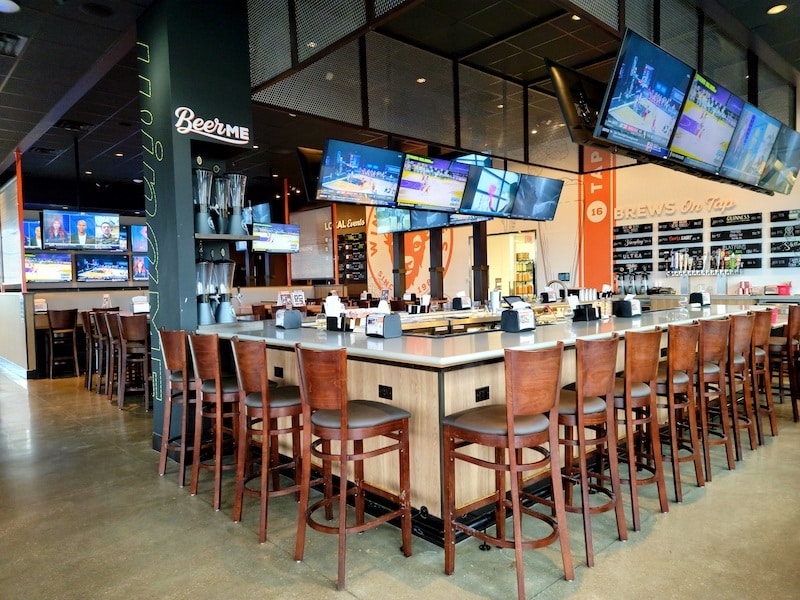
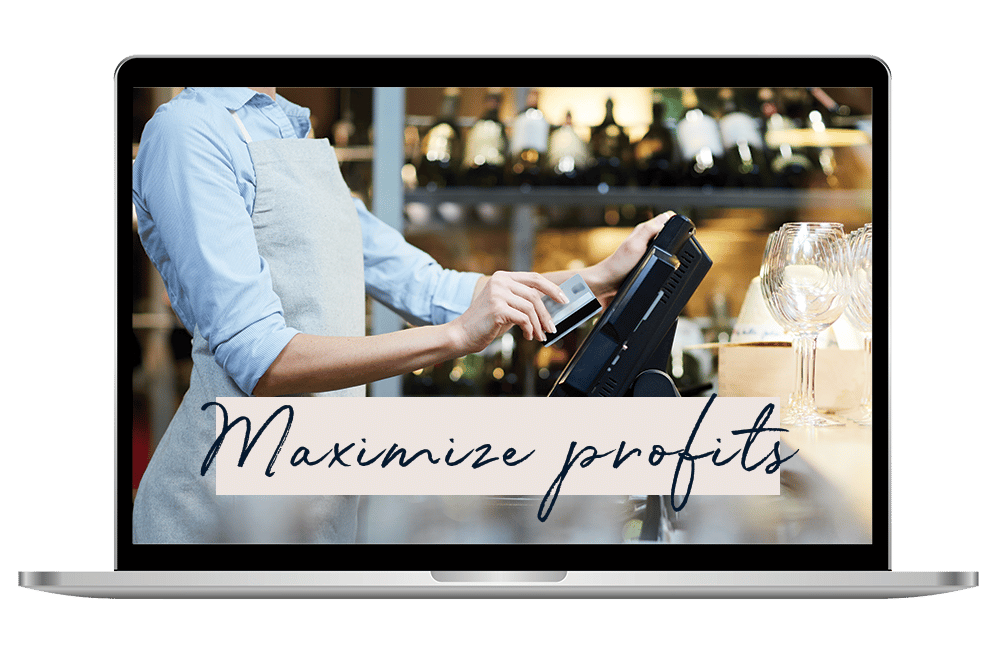
The three costly mistakes you could unknowingly be making?
Find out in this FREE guide and restaurant assessment specifically designed to reveal the unexpected hurdles standing between you and exponential business growth.
Thank You To Our Sponsors
Top equipment brands, extensive inventory, everyday low prices, and 60 years serving independent food service operators.
Increase restaurant sales, optimize guest throughput, and boost customer engagement all on one seamless platform.
Request a demo!
Want to become a podcast sponsor?
Please get in touch with Roger at roger@restaurantrockstars.com
